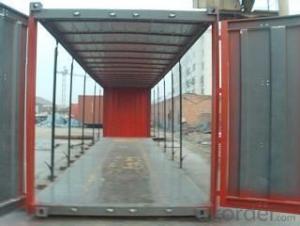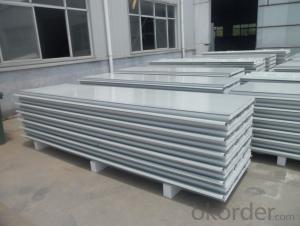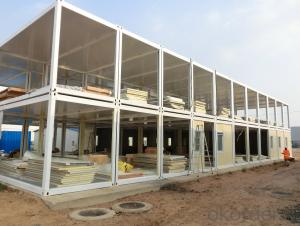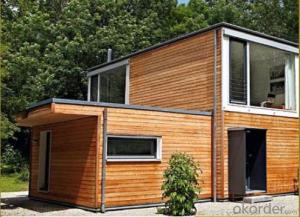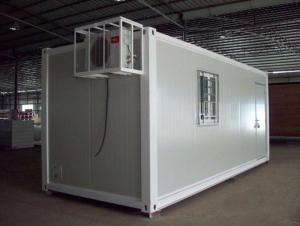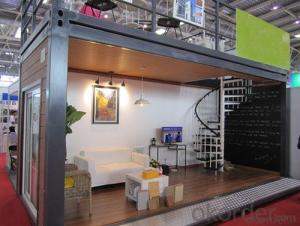Prefabricated Container House &home
- Loading Port:
- Tianjin
- Payment Terms:
- TT OR LC
- Min Order Qty:
- -
- Supply Capability:
- 20000 Set set/month
OKorder Service Pledge
OKorder Financial Service
You Might Also Like
Prefabricated Container House &home
| Item | Description |
| Name | prefab shipping container homes |
| Structure |
|
| Wall Panel |
|
| Insulation |
|
| Electrical |
|
| Door |
|
| Window |
|
| | |
- Q:Are container houses suitable for art galleries or exhibition spaces?
- Container houses can be a suitable choice for art galleries or exhibition spaces, as they offer several advantages. Their modular nature allows for easy customization and flexibility in creating unique and dynamic spaces. Additionally, the industrial and minimalist aesthetic of container houses can complement and enhance various art styles. Moreover, container houses are cost-effective and sustainable, making them an attractive option for artists or organizations with limited budgets and a focus on environmental consciousness. Overall, container houses can provide a creative and practical solution for art galleries or exhibition spaces.
- Q:What are the common amenities in container houses?
- Common amenities in container houses include basic necessities such as electricity, plumbing, and heating/cooling systems. These houses often have a kitchen area equipped with a stove, refrigerator, and sink, as well as a bathroom with a toilet, shower, and sink. Some container houses also include a small living area with furniture and a dining table. Additionally, containers can be modified to include windows for natural light and ventilation, insulation for temperature control, and storage spaces for belongings. Overall, the amenities in container houses aim to provide the essential comforts and functionality of a traditional home within the limited space of a shipping container.
- Q:Can container houses be designed with a vertical garden or living wall?
- Certainly, vertical gardens or living walls can be beautifully designed in container houses. In fact, container houses offer a unique opportunity to integrate greenery and plant life into the overall design. By making use of the vertical space on the container walls, you can create an aesthetically pleasing and functional living wall that not only adds visual appeal but also offers numerous advantages. A vertical garden or living wall in a container house can effectively enhance air quality by filtering pollutants and releasing oxygen. Moreover, it can serve as natural insulation, reducing the need for excessive heating or cooling. Additionally, the plants can absorb and retain rainwater, minimizing runoff and contributing to water conservation efforts. There are several ways to design and implement a vertical garden in a container house. One option is to attach a modular green wall system to the interior or exterior walls of the container. These systems usually consist of panels or trays that securely hold the plants and can be easily installed and maintained. Alternatively, you can opt for hanging pots or planters to create an impressive cascading effect of greenery. When designing a vertical garden in a container house, it is crucial to consider factors such as sunlight exposure, irrigation systems, and plant selection. Some plants thrive in low-light conditions, while others require direct sunlight. Proper irrigation is essential to ensure that the plants receive sufficient water without causing any harm to the container structure. Additionally, choosing plants that are well-suited for vertical growth and can withstand the container house environment is vital for the success of the living wall. Ultimately, incorporating a vertical garden or living wall in a container house can bring a refreshing and sustainable touch of nature to the living space. It is a creative and innovative means of utilizing the limited space in container homes while promoting an eco-friendly lifestyle.
- Q:Can container houses be designed to have a walk-in closet?
- Yes, container houses can be designed to have a walk-in closet. Despite the limited space, container houses can be customized and modified to accommodate various features, including walk-in closets. By cleverly utilizing the available area and incorporating efficient storage solutions, container house designs can successfully include walk-in closets to meet the homeowner's needs and preferences.
- Q:Can container houses be designed with a spacious interior?
- Yes, container houses can indeed be designed with a spacious interior. While containers are typically small in size, they can be converted and modified to create open and airy living spaces. Design techniques such as removing internal walls, adding windows, skylights, and utilizing multi-story designs can maximize the available space and create a sense of openness. Additionally, clever storage solutions and efficient furniture placement can further enhance the spaciousness of container homes. Thus, with proper planning and design, container houses can offer a comfortable and roomy living environment.
- Q:Can container houses be designed with a sustainable energy system?
- Yes, container houses can be designed with a sustainable energy system. There are various ways to incorporate sustainable energy systems into container houses, such as solar panels, wind turbines, and geothermal heating and cooling systems. Solar panels are a popular choice for container houses as they can be easily installed on the roof, providing a renewable source of electricity. These panels can harness the power of the sun and convert it into clean energy, reducing reliance on fossil fuels and lowering electricity bills. Additionally, excess energy generated by solar panels can be stored in batteries for use during cloudy periods or at night. Wind turbines can also be integrated into container houses, especially if they are located in areas with consistent wind patterns. These turbines can generate electricity from the wind and supply power to the house. Like solar panels, excess energy can be stored in batteries for later use. Furthermore, geothermal heating and cooling systems can be installed in container houses. These systems utilize the stable temperature of the ground to provide heating and cooling, reducing the need for traditional HVAC systems. Geothermal systems are highly efficient and can significantly lower energy consumption and costs. In addition to these specific sustainable energy systems, container houses can also incorporate energy-efficient appliances, LED lighting, and smart home technology to further reduce energy consumption. These features can help maximize the sustainability and efficiency of container houses. By combining these sustainable energy systems and practices, container houses can be designed to be highly energy-efficient and environmentally friendly. They offer a viable option for individuals and communities looking to minimize their carbon footprint and live in a more sustainable manner.
- Q:Are container houses suitable for guest or in-law accommodations?
- Yes, container houses can be suitable for guest or in-law accommodations. Container houses are versatile and can be easily customized to create comfortable living spaces. They offer the advantage of being portable, cost-effective, and environmentally friendly. With proper insulation and design modifications, container houses can provide all the necessary amenities and amenities required for guest or in-law accommodations.
- Q:Can container houses be designed to have a loft or mezzanine level?
- Container houses have the ability to be designed with a loft or mezzanine level. The flexible floor plans of these modular constructions easily allow for the incorporation of multiple levels. A loft or mezzanine level can serve various purposes, such as providing additional living space, creating separate areas for different functions, or functioning as a sleeping area. The vertical space in container houses can be effectively utilized, maximizing the available square footage and offering a unique and efficient living experience. Furthermore, the inclusion of a loft or mezzanine level can enhance the industrial aesthetic of container houses, resulting in visually appealing interior designs. In conclusion, container houses are highly adaptable and can be customized to meet different needs and preferences, including the addition of loft or mezzanine levels.
- Q:Can container houses be built with a contemporary design?
- Absolutely, container houses can be constructed with a contemporary aesthetic. The utilization of shipping containers as a construction material has become increasingly popular in recent years due to their affordability, sustainability, and versatility. By employing the appropriate design and architectural expertise, container houses can be transformed into fashionable and modern homes. Contemporary design is characterized by its sleek and minimalist appearance, clean lines, and incorporation of modern materials. These principles can be easily implemented in container houses. Architects and designers have the ability to integrate large windows and glass doors, creating an open and airy ambiance that maximizes natural light and blurs the distinction between indoor and outdoor spaces. Furthermore, container houses can be customized with a variety of exterior finishes and materials in order to achieve a contemporary look. This can involve cladding the containers with materials like wood, metal, or fiber cement panels, resulting in a more refined and sophisticated appearance. When it comes to interior design, container houses can also embrace contemporary elements. Open floor plans, minimalistic furnishings, and a neutral color palette can be employed to establish a clean and uncluttered living space. Modern fixtures, appliances, and lighting can be integrated to enhance the contemporary atmosphere. Container houses provide an exceptional opportunity for creativity and innovation in contemporary design. They can be stacked, joined together, or cantilevered to create captivating architectural forms and shapes. With the appropriate design approach, container houses can seamlessly blend with their surroundings and become a visually striking addition to any neighborhood. In conclusion, container houses can certainly be constructed with a contemporary design. The combination of the versatility of shipping containers and the principles of contemporary design can result in unique and stylish living spaces that are both sustainable and affordable.
- Q:Can container houses be built with a walk-in closet or storage area?
- Yes, container houses can be built with a walk-in closet or storage area. The versatile design of container houses allows for customization and the addition of various features, including walk-in closets or storage areas, depending on the specific needs and preferences of the homeowner.
1. Manufacturer Overview |
|
|---|---|
| Location | |
| Year Established | |
| Annual Output Value | |
| Main Markets | |
| Company Certifications | |
2. Manufacturer Certificates |
|
|---|---|
| a) Certification Name | |
| Range | |
| Reference | |
| Validity Period | |
3. Manufacturer Capability |
|
|---|---|
| a)Trade Capacity | |
| Nearest Port | |
| Export Percentage | |
| No.of Employees in Trade Department | |
| Language Spoken: | |
| b)Factory Information | |
| Factory Size: | |
| No. of Production Lines | |
| Contract Manufacturing | |
| Product Price Range | |
Send your message to us
Prefabricated Container House &home
- Loading Port:
- Tianjin
- Payment Terms:
- TT OR LC
- Min Order Qty:
- -
- Supply Capability:
- 20000 Set set/month
OKorder Service Pledge
OKorder Financial Service
Similar products
New products
Hot products
Hot Searches
Related keywords
